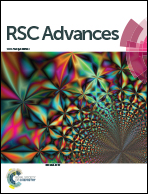Vibrational spectroscopic investigation on interaction of sago starch capped silver nanoparticles with collagen: a comparative physicochemical study using FT-IR and FT-Raman techniques
Abstract
In order to study the effect of sago starch as a capping agent, silver nanoparticles were synthesized via a chemical reduction method using different concentrations of sago starch (0.1–10 μM). These capped silver nanoparticles were added to collagen matrix and scaffolds in the form of sponges developed via lyophilization and they were analyzed using vibrational FTIR and FT-Raman spectroscopic techniques. These vibrational spectroscopic techniques show that the starch molecules are adsorbed on the surface of Ag colloids via their hydrophilic (–OH groups) moiety with the hydrophobic part exposed for possible interaction with collagen. Moreover, it was found that the increase of the starch concentration avoided aggregation and lead to formation of silver nanoparticles with lower size. Furthermore, sago starch in the concentration range 0.1–10 μM served as a matrix suitable for encapsulation and gradually releasing silver nanoparticles that imparted strong antibacterial properties to the collagen scaffolds fabricated for biomedical applications.


 Please wait while we load your content...
Please wait while we load your content...